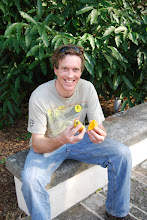 It's rainy season here in Costa Rica. This rainy season has been a bit drier than I am used to. We are greeted nearly every morning with blue skies and warm temperatures. By mid to late afternoon, the rain usually starts up. Sometimes it may only last an hour or two or sometimes it may go all night. Conditions are optimal for plant growth: plenty of sunlight and water. I took a morning stroll around the farm and captured some pictures of the showy flowering plants around Finca Carolina. Many Heliconia species are in bloom now which bring a diverse array of hummingbirds to sip their nectar. The bright red flower (Etlingera elatior) shown at right is a member of the Zingiberaceae family and employs showy red bracts to attract pollinators. Known also as torch Ginger or Emperor's Staff, this plant grows vigorously and makes a colorful addition to a tropical landscape.
It's rainy season here in Costa Rica. This rainy season has been a bit drier than I am used to. We are greeted nearly every morning with blue skies and warm temperatures. By mid to late afternoon, the rain usually starts up. Sometimes it may only last an hour or two or sometimes it may go all night. Conditions are optimal for plant growth: plenty of sunlight and water. I took a morning stroll around the farm and captured some pictures of the showy flowering plants around Finca Carolina. Many Heliconia species are in bloom now which bring a diverse array of hummingbirds to sip their nectar. The bright red flower (Etlingera elatior) shown at right is a member of the Zingiberaceae family and employs showy red bracts to attract pollinators. Known also as torch Ginger or Emperor's Staff, this plant grows vigorously and makes a colorful addition to a tropical landscape.
I had the good fortune of acquiring some cuttings of a variegated Yuca plant (photos below). Yuca, or Manihot esculenta (Cassava) is a staple starch crop throughout the New World Tropics. This variety also makes an edible root in addition to the vibrant leaves. Yuca is one of those great tropical plants that you can literally plant a branch in the ground and it will grow.


Manihot esculenta
Another plant of interest that is fruiting right now is chocolate. Chocolate? Well, chocolate doesn't exactly grow on trees but cacao seeds do which must be dried, roasted and ground before being processed into cocoa butter from which the chocolate we eat is made. The cacao seeds are rich in antioxidants and a variety of alkaloids all of which contribute to the feeling of well being one experiences after eating some good chocolate. The seeds themselves are quite bitter so lots of sugar must be added to arrive at a chocolate resembling what we eat. Theobroma cacao was domesticated by Central American Pre-Colombian Indians and a chocolate beverage made from the ground seeds is still enjoyed by indigenous people throughout the region. In addition, the football shaped capsules showed in photos below contain a rich, white, edible, sweet pulp surrounding the seeds.


Theobroma cacao
The White nosed Coati or Pizote (Nasua narica) is a raccoon like animal found from Arizona south to Colombia and Argentina. They are omnivores who spend their days foraging for fruits, insects, and small invertebrates. The individual seen in this picture has been visiting the edges of the garden for weeks now. He scratches the ground for eaarthworms and agilely climbs and descends trees. The tree he is climbing is a Cecropia (Cecropia spp) or Guarumo, a pioneer species tree that produces great quantities of a legume-like fruit (botanically an achene), attract a wide range of creatures. At Finca Carolina this includes striking birds like the Firey-billed Aracari (Pteroglossus frantzii) or Cusinga and the Chestnut-mandibled Toucan (Ramphastos swainsonii). Only the older Pizotes live solitary lifestyles so he is likely an adult male. Younger males, females, and offspring live in bands of 5-25 members. At Finca Carolina, I have encountered such groups and they typically flee quickly from human presence. This individual, however, is remarkably unafraid of us. The Pizote is just one of the many species of animal life that UTSI is trying to protect with our Nature Reserve. All photos were taken at Finca Carolina de Uvita, in Uvita, Costa Rica.








No comments:
Post a Comment